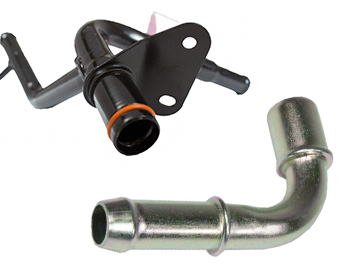Wooley Tube End Form Service
Wooley's end forming process in tube manufacturing is a crucial step that involves shaping the ends of metal tubes to achieve specific configurations.
This process is widely used in the automotive, aerospace, plumbing, and furniture manufacturing, industries, where the shape of the tube ends plays a vital role in the overall functionality of the finished product.
The first step is selecting the appropriate material for the tubes based on the application requirements. Common materials include steel, aluminum, stainless steel, and copper.
Tubes are cut to the desired length, and their ends are prepared by cleaning, deburring, and ensuring they are free from any imperfections. Proper preparation is essential for achieving precise end forming results.

End forming machines are employed to shape the tube ends. These machines can be equipped with various tooling options, depending on the desired end configuration. The setup includes selecting the appropriate tooling, adjusting parameters, and ensuring the machine is calibrated for the specific tube dimensions.
There are several end forming processes, each serving different purposes:
Expanding: Enlarging the diameter of the tube end.
Reducing: Decreasing the diameter of the tube end.
Flaring: Creating a flared or bell-shaped end.
Swaging: Reducing or tapering the tube diameter through radial pressure.
Beading: Forming a raised or indented feature around the tube end.
The tube is securely clamped in the end forming machine, and the selected tooling is applied to shape the tube end. The machine exerts controlled force to achieve the desired end configuration accurately.
Modern tube cutting machines often feature automation and CNC (computer numerical control) technology. This allows for high repeatability, accuracy, and the ability to handle complex cutting patterns.
Throughout the end forming process, quality control measures are implemented to ensure that the tube ends meet dimensional specifications. Inspections may include checking for uniformity, dimensional accuracy, and the absence of defects.
After end forming, the tubes undergo deburring to remove any sharp edges or excess material. Cleaning processes may also be applied to ensure the end-formed tubes meet cleanliness standards.
Depending on the application, additional operations such as welding, threading, or assembly may follow the end forming process to prepare the tubes for their intended use.
The end-formed tubes may undergo additional finishing processes, such as coating, plating, or polishing, to enhance their appearance or provide corrosion resistance.
Once the end forming process is completed, the tubes are packaged and prepared for shipping to the end-user or subsequent manufacturing stages.
The end forming process is essential for achieving specific configurations at the ends of metal tubes, contributing to the overall functionality and performance of the final products in various industries. If you're ready to get your ends formed, get in touch. We Just Work!
Ready to Get Started?
✓ Free quotes within 1 business day
✓ 70+ years of manufacturing experience
✓ Serving Michigan and surrounding states
✓ Prototype to high-volume production
Get A Quote

Advanced Tube Forming for Aerospace Applications
We provide precision aerospace tube forming for suppliers throughout the Great Lakes region, including Detroit, Cleveland, and Indianapolis. Our specialized processes meet strict aerospace standards for accuracy, safety, and performance.
Capabilities for Aerospace Tubing
- Tight-tolerance CNC tube bending
- Exotic alloy forming (titanium, Inconel, stainless)
- Prototype and certified production runs
- NADCAP-ready processes
Read more: Aerospace Tube Forming Services in the Great Lakes Region
